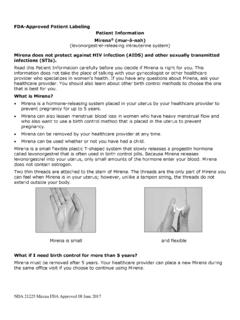Transcription of mirena patient information - Mirena Global Website
1 Page: 1of 17 Mirena patient information This provides medical and scientific information on Mirena in general. Please refer to the local patient information Leaflet for the information applicable in your country. Page: 2of 17 PACKAGE LEAFLET: information FOR THE USER Mirena 20 micrograms/24 hours intrauterine delivery system Levonorgestrel Read all of this leaflet carefully before you start using this medicine. Keep this leaflet. You may need to read it again. If you have any further questions, ask your doctor or pharmacist. This medicine has been prescribed for you. Do not pass it on to others. It may harm them, even if their symptoms are the same as yours. If any of the side effects gets serious, or if you notice any side effects not listed in this leaflet, please tell your doctor or pharmacist.
2 In this leaflet: 1. WHAT Mirena IS AND WHAT IT IS USED FOR .. 3 2. BEFORE YOU USE Mirena .. 3 3. HOW TO USE Mirena .. 8 4. POSSIBLE SIDE EFFECTS .. 12 5. HOW TO STORE Mirena .. 13 6. FURTHER 14 7. information FOR HEALTHCARE PROFESSIONALS .. 14 Page: 3of 17 1. WHAT Mirena IS AND WHAT IT IS USED FOR Mirena is a T-shaped intrauterine delivery system (IUS) which after insertion releases the hormone levonorgestrel into the womb. The purpose of the T-body is to adjust the system to the shape of the womb. The vertical arm of the T-body carries a drug reservoir containing levonorgestrel. Two removal threads are tied to the loop at the lower end of the vertical arm. Mirena is used for: Contraception (prevention of pregnancy) Idiopathic menorrhagia (excessive menstrual bleeding) Protection from endometrial hyperplasia (excessive growth of the lining of the womb) during estrogen replacement therapy.
3 2. BEFORE YOU USE Mirena General notes Before you can begin using Mirena , your doctor will ask you some questions about your personal health history and that of your close relatives. About 2 in a 1000 women correctly using Mirena become pregnant in the first year. About 7 in a 1000 women correctly using Mirena become pregnant in five years. In this leaflet, several situations are described where Mirena should be removed, or where the reliability of Mirena may be decreased. In such situations you should either not have sex or you should take extra non-hormonal contraceptive precautions, use a condom or another barrier method. Do not use rhythm or temperature methods. These methods can be unreliable because Mirena alters the monthly changes of body temperature and cervical mucus.
4 Mirena , like other hormonal contraceptives, does not protect against HIV infection (AIDS) or any other sexually transmitted disease. Do not use Mirena under any of the following conditions: if you are pregnant or think you might be pregnant if you currently or recurrently have a pelvic inflammatory disease (infection of the female reproduction organs) if you have a lower genital tract infection if you have an infection of the womb after delivery if you have had an infection of the womb after abortion during the past 3 months if you have an infection of the cervix (neck of the womb) Page: 4of 17 if you have cell abnormalities in the cervix if you have cancer or suspected cancer of the cervix or womb if you have tumors which depend on progestogen hormones to grow, if you have unexplained abnormal vaginal bleeding if you have an abnormality of the cervix or womb including fibroids if they distort the cavity of the womb if you have conditions associated with increased susceptibility to infections if you have an active liver disease or liver tumor if you are hypersensitive (allergic) to levonorgestrel or to any of the other ingredients of Mirena .
5 Take special care with Mirena Consult a specialist who may decide to continue using Mirena or remove the system if any of the following conditions exists or appears for the first time while using Mirena : migraine, asymmetrical visual loss or other symptoms which may be signs of a transient cerebral ischemia (temporary blockage of the blood supply to the brain) exceptionally severe headache jaundice (a yellowing of the skin, whites of the eyes and/or nails) marked increase of blood pressure severe disease of arteries such as stroke or heart attack. Mirena may be used with caution in women who have congenital heart disease or valvular heart disease at risk of infective inflammation of the heart muscle. Antibiotic preventive medication should be administered to these patients when inserting or removing Mirena .
6 In diabetic users of Mirena , the blood glucose concentration should be monitored. However, there is generally no need to change your diabetic treatment while using Mirena . Irregular bleedings may mask some symptoms and signs of endometrial polyps or cancer, and in these cases diagnostic measures have to be considered. Mirena is not the method of first choice for young women who have never been pregnant, nor for postmenopausal women with shrinking of the womb. Available data shows that Mirena does not increase the risk for breast cancer in pre-menopausal women under 50 years of age. Due to the limited data from Mirena trials in the indication protection from endometrial hyperplasia (excessive growth of the lining of the womb) during estrogen replacement therapy, a breast cancer risk when Mirena is used in this indication cannot be confirmed or eliminated.
7 Medical examination/consultation Page: 5of 17 Examination before insertion may include a cervical smear test (Pap smear), examination of the breasts and other tests, for infections, including sexually transmitted diseases, as necessary. A gynecological examination should be performed to determine the position and size of the womb. Mirena is not suitable for use as postcoital contraceptive (used after intercourse). Infections The insertion tube helps to prevent Mirena from contamination with micro-organisms during the insertion, and the Mirena inserter has been designed to minimize the risk of infections. Despite this, there is an increased risk of pelvic infection immediately and during the first month after the insertion in Copper IUD users. Pelvic infections in IUS (Intra Uterine System) users are often related to sexually transmitted diseases.
8 The risk of infection is increased if the woman or her partner has several sexual partners. Pelvic infections must be treated promptly. Pelvic infection may impair fertility and increase the risk of a future extrauterine pregnancy (pregnancy outside the womb). In extremely rare cases severe infection or sepsis (very severe infection, which may be fatal) can occur shortly after IUD insertion. Mirena must be removed if there are recurrent pelvic infections or infections of the lining of the womb, or if an acute infection is severe or does not respond to treatment within a few days. Consult a doctor without delay if you have persistent lower abdominal pain, fever, pain in conjunction with sexual intercourse or abnormal bleeding. Severe pain or fever developing shortly after insertion may mean that you have a severe infection which must be treated immediately.
9 Expulsion The muscular contractions of the womb during menstruation may sometimes push the IUS out of place or expel it. Possible symptoms are pain and abnormal bleeding. If the IUS is displaced, the effectiveness may be reduced. If the IUS is expelled, you are not protected against pregnancy anymore. It is recommended that you check for the threads with your finger, for example while having a shower. If you have signs indicative of an expulsion or you cannot feel the threads, you should avoid intercourse or use another contraceptive, and consult your doctor. As Mirena decreases menstrual flow, increase of menstrual flow may be indicative of an expulsion. Perforation Rarely, most often during insertion, Mirena may penetrate or perforate the wall of the womb which may decrease the protection against pregnancy.
10 An IUS which has become lodged outside the cavity of the womb is not effective and must be removed as soon as possible. The risk of perforation is increased in breastfeeding women, and may be increased if Mirena is inserted shortly after delivery (see section 3. When should Mirena be inserted? ) or in women with the uterus fixed and leaning backwards (towards the bowel). Page: 6of 17 Extrauterine pregnancy It is very rare to become pregnant while using Mirena . However, if you become pregnant while using Mirena , the risk that you could carry the fetus outside of your womb (have an extrauterine pregnancy) is relatively increased. About 1 in a 1000 women correctly using Mirena have an extrauterine pregnancy per year. This rate is lower than in women not using any contraception (about 3 to 5 in a 1000 women per year).






